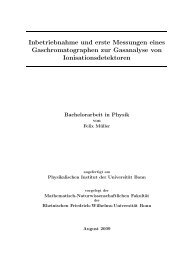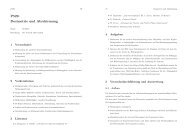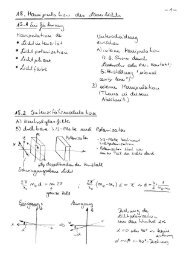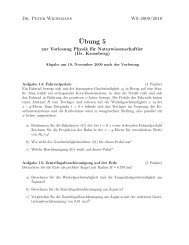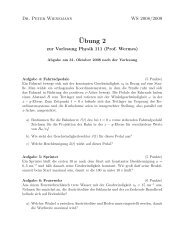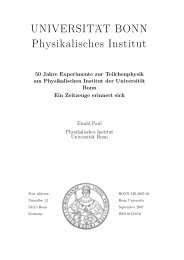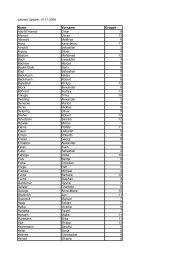You also want an ePaper? Increase the reach of your titles
YUMPU automatically turns print PDFs into web optimized ePapers that Google loves.
ATLAS <strong>3D</strong>Si Sensors<br />
Project Status Report<br />
Ole Myren Røhne, University of Oslo<br />
For the ATLAS <strong>3D</strong>Si R&D Project
Outline<br />
• Progress at the fabrication facilities<br />
• Lab characterization<br />
• Measurements w/ATLAS FE-I3<br />
• Test beam program<br />
• Outlook
The <strong>3D</strong>Si ATLAS Upgrade R&D Project<br />
Development, Testing and Industrialization of Full-<strong>3D</strong> Active-Edge<br />
and Modified-<strong>3D</strong> Silicon Radiation Pixel Sensors with<br />
Extreme Radiation Hardness Results, Plans.<br />
Proponents: C. Da Viá, S. Parker, G. Darbo<br />
Status: APPROVED<br />
Topics and goals of the R&D proposal:<br />
The primary goal is the development, fabrication, characterization, and testing, with and without the front-end readout chip, of Full-<strong>3D</strong>– activeedge<br />
and Mod-<strong>3D</strong> silicon <strong>pixel</strong> sensors of extreme radiation hardness and high speed for the the Super-LHC ATLAS upgrade and, possibly, the<br />
ATLAS B-layer replacement. A secondary goal is to start design work for a reduced material B-layer <strong>detector</strong> module using these sensors.<br />
FP420 is used as a test bench for the technology<br />
Participating ATLAS Institutions: 10<br />
Bonn University, Freiburg University, University of Genova, Glasgow University, the University of Hawaii, Lawrence Berkeley National<br />
Laboratory, Manchester University, the University of New Mexico, Oslo University and the Czech Technical University.<br />
Fabrication Facilities: 4<br />
CNM/Valencia, IceMOS/Belfast, IRST/Trento and SINTEF/Oslo.<br />
At present C. Kenney (Molecular Biology Consortium) and Jasmine Hasi (Manchester University), working at the Stanford Nanofabrication<br />
Facility, made all of the Full-<strong>3D</strong> sensors. For this project industrial companies will join the above mentioned institutions to study the feasibility<br />
of a large volume production in time for the upgrade.
<strong>3D</strong>Si basics<br />
• MEMS technology + VLSI to sensor fab: Deep Reactive Ion Etching (DRIE)<br />
• Electrode implants: etched, doped, filled columns (S. Parker 1995)<br />
• Dicing: etched, doped edge trench (C. Kenney 1997)<br />
• Key benefits: Radiation hardness and active edges<br />
wafer diced by<br />
etching edges doped<br />
Silicon chip<br />
n - and p – electrode holes<br />
etched through wafer. Doped<br />
and filled with poly-silicon
Fabrication facilities: Overview<br />
Full <strong>3D</strong><br />
Active edge<br />
iceMOS- Being presently fabricated<br />
Work performed in the RD50 framework<br />
(No data available yet)<br />
The <strong>3D</strong> sensors family:<br />
<strong>3D</strong>C Fabricated at Stanford<br />
and tested with Atlas <strong>pixel</strong><br />
Readout – and SLHC fluences<br />
Design at its 5 th<br />
Generation<br />
Being also fabricated at SINTEF in<br />
the ATLAS Upgrade framework as<br />
part of the <strong>3D</strong>C Consortium.<br />
(No data available yet)<br />
Full <strong>3D</strong><br />
No active edge<br />
Single column<br />
No active edge<br />
IRST and separately CNM.<br />
Being presently fabricated<br />
(No data available yet)<br />
IRST/CNM fabricated in the RD50<br />
Framework in 2005 Tested with SCTA<br />
readout Electronics. Data and Simulations<br />
show that the design is NOT radiation hard<br />
For B-layer replacement.<br />
Double column<br />
No active edge
CNM (Barcelona/Valencia)<br />
FIRST BATCH COMPLETED<br />
•First run on n-type substrate, p-type column read-out<br />
(not usable w/FE-I3)<br />
•Strip sensor w/Beetle chip<br />
•Basic characterization started in CNM, Glasgow<br />
•Next run starting before end 2007: p-type substrate, ntype<br />
column<br />
p-on-n<br />
300-250µm<br />
Full depletion occurs at 2-3 V since<br />
the electrode pitch is 55µm<br />
Strips
FBK-IRST (Trento, Italy)<br />
FIRST BATCH COMPLETED<br />
<strong>3D</strong> Double-side Double-Type Column (<strong>3D</strong>-DDTC) <strong>detector</strong>s<br />
Detector concept able to ease the fabrication process, and<br />
expected to have performance comparable to standard <strong>3D</strong><br />
<strong>detector</strong>s (if d is much smaller than t )<br />
First batch (p-on-n version) completed at FBK-irst in October<br />
2007 Second batch (n-on-p) available by the end of 2007<br />
<strong>3D</strong> diodes2.56mm 2 area<br />
Single-Type-Column<br />
80 μm pitch,<br />
400 columns<br />
100 μm pitch,<br />
256 columns<br />
G.F. Dalla Betta, IEEE-NSS 2007, N18-3<br />
• Very low lateral depletion voltage(
IceMOS (Glasgow)<br />
FIRST BATCH will be COMPLETED by end of 2007<br />
• Full-<strong>3D</strong> sensors<br />
• No support wafer<br />
• Etch from top, back-grind<br />
• First run: p-on-n<br />
SAMPLES EXPECTED BEFORE END 2007
SINTEF/Stanford<br />
(<strong>3D</strong>C Hawaii, Manchester, Oslo, Prague, SINTEF)<br />
FIRST BATCH will be COMPLETED by end 2007<br />
• Implement Stanford design “technology transfer”<br />
• 2nd source full-<strong>3D</strong> active-edge sensors<br />
• In-house DRIE etching<br />
• Out-of-house polysilicon filling<br />
WAFER AFTER 2nd ELECTRODE FILLING AT<br />
STANFORD<br />
Ready for contact hole opening and metal<br />
PROCESSING WILL BE COMPLETED BY<br />
THE END OF 2007<br />
Detail of hole<br />
Detail from wafer showing holes and trench<br />
2
Stanford (Manchester)<br />
<strong>3D</strong> electrode configurations<br />
Design and fabrication by:<br />
J. Hasi, Manchester<br />
C. Kenney, MBC at CIS-Stanford<br />
50 µm<br />
50 µm<br />
50 µm<br />
2E<br />
400 µm<br />
p 103µm<br />
Vfd ~20V<br />
3E<br />
400 µm<br />
4E<br />
n<br />
n<br />
p<br />
71 µm<br />
Vfd ~8V<br />
400 µm<br />
p<br />
Vfd ~5V<br />
n<br />
56 µm<br />
Thickness <br />
p-type substrate 12kΩcm<br />
Baby-2E Baby-3E<br />
Financial support:<br />
STFC-UK for the FP420 project<br />
DOE, USA for ATLAS Upgrade<br />
10 wafers competed. Yield~80% (1 wafer)<br />
Atlas chip<br />
picture from<br />
Bekerle<br />
Vertex03<br />
ATLAS <strong>pixel</strong> chip<br />
7.2 x 8 mm 2<br />
2880 <strong>pixel</strong>s
<strong>3D</strong>Si basics - Radiation hardness<br />
• Decoupled directions: track traversal versus drift field<br />
• Low depletion voltage<br />
• Short charge collection path, fast signal<br />
• Retain full charge from MIP in 250μm Si<br />
• Signal loss dominated by trapping
Radiation hardness<br />
Irradiation and measurements performed in Prague<br />
C. Da Viá, T. Slaviceck, V. Linhart, P. Bem, S. Parker,<br />
S. Pospisil, S. Watts (process J. Hasi, C. Kenney)<br />
Samples/fluence As measured<br />
n/cm 2<br />
1MeV n<br />
(1.784)<br />
n/cm 2<br />
Protons<br />
(1/0.51)<br />
p/cm 2<br />
2E, 3E, 4E 4.23 10 14 7.55 10 14 1.48 10 15<br />
2E, 3E, 4E 1.12 10 15 2.00 10 15 3.92 10 15<br />
2E, 3E, 4E 4.94 10 15 8.81 10 15 1.73 10 16<br />
bias<br />
T=-20C<br />
IR Laser<br />
1060nm<br />
Gain = ~10000<br />
Oscilloscope
Radiation Hardness tests with neutrons<br />
using an IR laser source<br />
Irradiation and measurements performed in Prague<br />
C. Da Viá, T. Slaviceck, V. Linhart, P. Bem, S. Parker,<br />
S. Pospisil, S. Watts (process J. Hasi, C. Kenney)<br />
50 µm<br />
50 µm<br />
50 µm<br />
p<br />
2E<br />
V fd ~20V<br />
p<br />
V fd ~8V<br />
V fd ~5V<br />
400 µm<br />
3E<br />
400 µm<br />
4E<br />
n<br />
103µm<br />
400 µm<br />
p<br />
n<br />
71 µm<br />
n<br />
56µm<br />
2E<br />
9000e -<br />
V b ~130V<br />
3E<br />
10200e -<br />
V b ~112V<br />
4E<br />
13200e -<br />
V b ~94V<br />
C. DA VIA presented at the IEEE-NSS 2007<br />
threshold<br />
threshold<br />
threshold<br />
45%<br />
51%<br />
66%<br />
8.81x10 15 n/cm 2<br />
1.73x10 16 p/cm 2
Tests with the FE-I3 chip<br />
Bump bonded at IZM in 2006<br />
Mounted in Bonn<br />
Leakage currents<br />
before irradiation<br />
~325 pA/<strong>pixel</strong><br />
Noise vs<br />
Bias voltage<br />
Tests by E. Bolle, O. Rohne (Oslo) help from M. Garcia-Sciveres and K. Einweiler (LBL)
Estimated S/N at<br />
3.5x10 15 n/cm 2 and 8.81x10 15 n/cm 2<br />
Initial measurements, error bars<br />
would require more statistics<br />
Noise measured on non-irradiated bump-bonded<br />
FE-I3-ATLAS chip<br />
Noise measurements performed at CERN by E. Bolle and O. Rohne (Oslo)<br />
Help from K. Einweiler, M. Garcia-Sciveres (LBL), data analysis and plots from<br />
C. Da Via (Manchester)
Time walk with the FE-I3 chip<br />
•Threshold triggered system<br />
•Difference between t and t gives the time walk<br />
•New bunch crossing every 25ns<br />
•Need to cross threshold within 20ns to be accepted<br />
•How much overdrive is needed to cross threshold within 20ns?<br />
ASIC<br />
settings<br />
sensors<br />
IP = 64<br />
IL = 64<br />
IP = 128 1<br />
IL = 96<br />
Measurements by E. Bolle, K. Einweiler, O.Rohne. Plots by C. Da Viá<br />
IL68 IP68 – STANDARD PLANAR SETTINGS: Analogue current=91mA., VDDA = 1.6V and VDD = 2.0V<br />
IL96 IP128- Analogue current=126mA (+38%) VDDA = 1.6V VDD= 2.0V<br />
IL64 IP192 Analogue current =158mA (+76%) VDDA = 1.6V VDD= 2.0V<br />
IP = 196 2<br />
IL = 64<br />
2E-A 1807e - 1119e - 813e -<br />
3E-G 2798e - 1828e - 1434e -<br />
4E-C 3338e - 2122e - 1597e -<br />
Planar 1244e -
Data analysis<br />
By M. Mathes/Bonn<br />
Test beam setup 2006 M. Mathes, Presented at the IEEE-NSS 2007<br />
Picture by F. Roncarolo<br />
Manchester<br />
M. Mathes1, C. DaVia2, J. Hasi2, S. Parker3, M. Ruspa4,<br />
L. Reuen1, J. Velthuis1, S. Watts2, M. Cristinziani1, K.<br />
Einsweiler4, M. Gracia-Sciveres4,K. Kenney5, N. Wermes1<br />
1Bonn, Germany<br />
2Manchester University, UK<br />
3University of Hawaii, USA<br />
4LBL, Berkeley, USA<br />
5Molecular Biology Consortium, Stanford, USA<br />
Analysis<br />
By S. Watts/Manchester Beam profile<br />
Using 3x3mm 2<br />
scintillator
Tracking efficiency – 2006 test beam<br />
bump-bonding at IZM (Bonn)- not problematic<br />
M. Mathes1, C. DaVia2, J. Hasi2, S. Parker3, M. Ruspa4,<br />
L. Reuen1, J. Velthuis1, S. Watts2, M. Cristinziani1, K.<br />
Einsweiler4, M. Gracia-Sciveres4,K. Kenney5, N. Wermes1<br />
1Bonn, Germany<br />
2Manchester University, UK<br />
3University of Hawaii, USA<br />
4LBL, Berkeley, USA<br />
5Molecular Biology Consortium, Stanford, USA<br />
beam<br />
0 o<br />
ε = (95.9 ± 0.1) %<br />
beam<br />
15 o<br />
ε = (99.9 ± 0.1) %<br />
3E 3200 e -<br />
threshold<br />
Data analyisis and silulation by M. Mathes, M. Cristinziani (Bonn)<br />
S. Watts (Manchster)<br />
data<br />
simulation<br />
data<br />
simulation
Test beam 2007<br />
• Infrastructure from ATLAS Pixel TB<br />
• Stanford full <strong>3D</strong> FE-I3, irrad’ed<br />
• IRST STC <strong>3D</strong> strips<br />
• FP420 “blades” (Stanford full-<strong>3D</strong> FE-I3)<br />
Participating Institutions:<br />
Bonn, CERN, Freiburg, Glasgow, Hawaii, Manchester, Oslo,<br />
Prague, Trento
Test beam 2007 - preliminary plots<br />
IRST STC strip correlation with telescope<br />
Stanford full-<strong>3D</strong> (Håvard Gjersdal, Oslo)<br />
Stanford full-<strong>3D</strong> time vs charge
Active edge (Kenney 97)<br />
• DRIE trench etch can replace saw<br />
dicing<br />
• Horizontal field, no need for guard<br />
ring structures<br />
• Edge itself is an electrode<br />
• 2-way butt-able, edge sensitive<br />
tiles<br />
~4µm<br />
trench<br />
electrode
Conclusions and 2008 Plans<br />
<strong>3D</strong>Si project formed and approved as ATLAS upgrade project<br />
Tests with <strong>3D</strong>+FE-I3 chip completed and promising:<br />
S/N estimated before and after irradiation<br />
Time walk under control with moderate extra power<br />
Radiation Hardness proven with neutrons and IR laser source:<br />
IRRADIATED <strong>3D</strong>-<strong>pixel</strong> assembly (1x10 15 p/cm 2 ) under bias tested at RT in the beam<br />
WORKED! More tests after bonding mystery solved…<br />
ACTIVE EDGE PROCESSING : standard in Stanford and SINTEF, will be implemented<br />
at CNM, IceMOS, IRST<br />
ALL COMMERCIAL PARTNERS COMPLETED FIRST BATCH<br />
CNM / Barcellona-Valencia<br />
IceMos/Glasgow<br />
IRST/Trento<br />
SINTEF/Stanford<br />
First common test beam completed in October 2007 – data being analysed<br />
PLANS:<br />
Test beam period requested for 1 week in June and 1 in November 2008<br />
Irradiations and tests will be performed at CERN (common lab-space) and Institutes<br />
OVERALL PROGRESS ENCOURAGING!!!
Back-up slides
TIMESCHEDULE 3-D PROCESSING AT SINTEF<br />
6-weeks delay waiting for fix of boron deposition tube.<br />
Did go to Stanford instead for poly silicon filling of electrodes<br />
Expected completion January 04, 2008<br />
ICT



